Daffodils, with their bright, cheerful blooms, are a beloved addition to gardens worldwide. Known for their trumpet-shaped flowers and vibrant yellow hues, daffodils herald the arrival of spring and are appreciated for their beauty and resilience. This comprehensive guide will explore everything you need to know about daffodils, including planting, care, and blooming tips to ensure a stunning display in your garden. Our blog is a perfect place to find all the information you need.
Understanding Daffodils
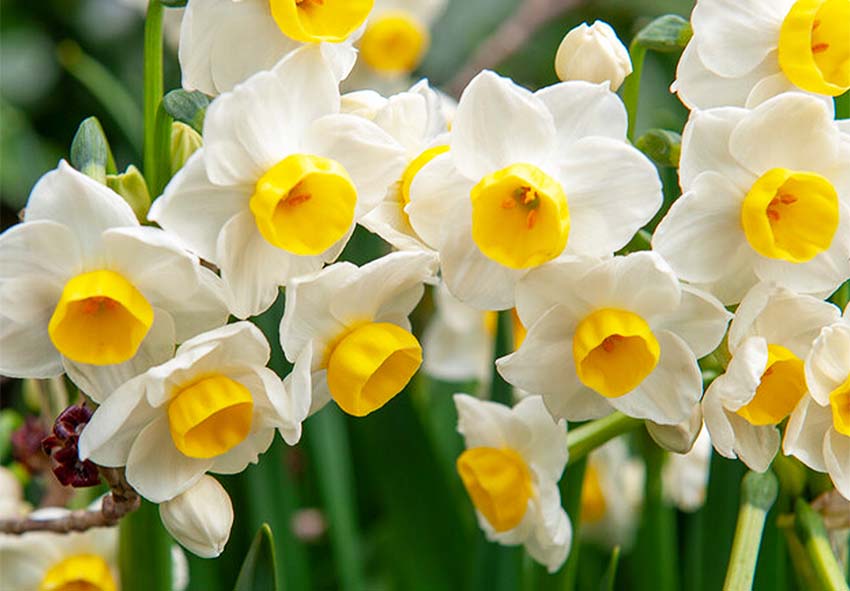
Daffodils are a garden favorite, celebrated for their striking blooms and low-maintenance nature. These hardy perennials not only add a burst of color to spring landscapes but also symbolize renewal and new beginnings. In this section, we will delve into the characteristics of daffodils and explore the various popular varieties that can enhance your garden’s aesthetic appeal.
What Are Daffodils?
Daffodils, scientifically known as Narcissus, are perennial plants that belong to the Amaryllidaceae family. They are characterized by their trumpet-like central corona surrounded by a ring of petals. Daffodils come in various colors, including yellow, white, orange, and even pink, though yellow is the most common. These flowers are not only visually appealing but also relatively easy to grow, making them a favorite among gardeners of all skill levels.
Popular Varieties of Daffodils
There are numerous daffodil varieties, each with unique characteristics. Some of the popular varieties include:
| Botanical Name | Color | Flowering Period | Fragrance | Ideal for Containers |
| Narcissus ‘King Alfred’ | Yellow | Early to mid-spring | Mild | No |
| Narcissus ‘Ice Follies’ | White with yellow cup | Mid-spring | Slight | Yes |
| Narcissus ‘Thalia’ | White | Late spring | Fragrant | Yes |
| Narcissus poeticus | White with orange edge | Late spring | Fragrant | No |
Planting Daffodils
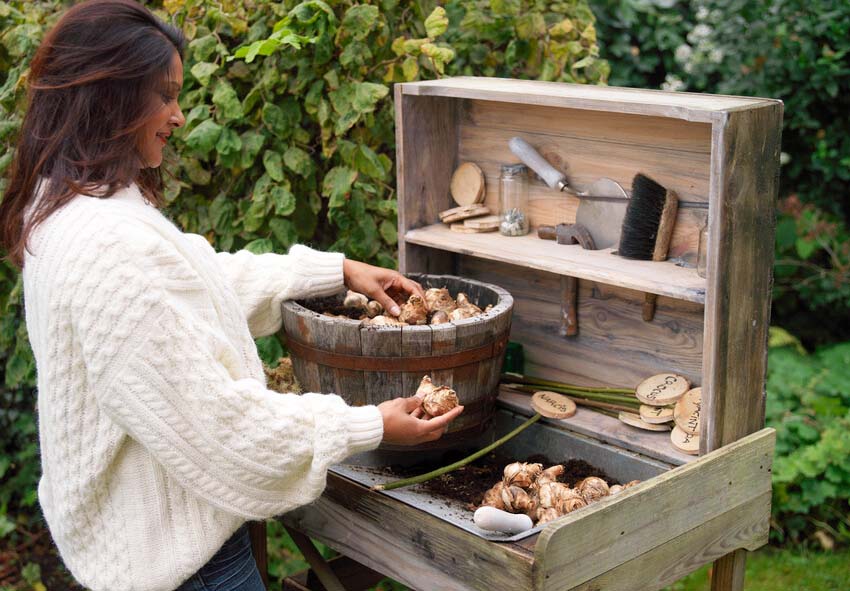
Planting daffodils is a rewarding endeavor that brings vibrant color and cheerful blooms to gardens each spring. Known for their resilience and effortless beauty, daffodils are a staple in many landscapes, brightening up borders, beds, and containers alike. This section provides essential guidance on selecting the right bulbs, choosing optimal planting times and locations, preparing the soil, and executing proper planting techniques to ensure successful growth and abundant flowering of daffodils in your garden.
Choosing the Right Bulbs
When selecting daffodil bulbs from a store or nursery, look for bulbs that are firm and free of any mold or soft spots. Healthy bulbs should be large, plump, and dry. Avoid bulbs that are shriveled, discolored, or showing signs of decay. Choosing high-quality bulbs is crucial as they are more likely to produce strong, vibrant flowers.
When and Where to Plant
The best time to plant daffodil bulbs is in the fall, typically from September to November, before the ground freezes. This timing allows the bulbs to establish roots before winter sets in. Select a location that receives full sun to partial shade. Daffodils thrive in well-draining soil with a slightly acidic to neutral pH. Avoid areas where water tends to pool, as soggy soil can lead to bulb rot.
Soil and Potting Requirements
Daffodils prefer well-draining soil rich in organic matter. Before planting, prepare the soil by loosening it to a depth of 12-15 inches and mixing in compost or well-rotted manure. If planting in containers, use a high-quality potting mix that drains well. Ensuring the soil has the right balance of nutrients will help the bulbs grow strong and healthy.
Step-by-Step Planting Instructions
Following these steps will help ensure your daffodil bulbs are planted correctly and have the best chance to thrive and produce beautiful blooms in the spring:
- Digging the Holes: Dig holes 6-8 inches deep, ensuring there is enough space between each hole to accommodate the bulbs.
- Placing the Bulbs: Place the bulbs in the holes with the pointed end facing up. This orientation helps the shoots grow upward easily.
- Covering with Soil: Fill the holes with soil, gently firming it around the bulbs to eliminate air pockets.
- Watering: Water the newly planted bulbs thoroughly to help settle the soil and initiate root growth. Regular watering is essential, especially if the fall is dry, to ensure the bulbs establish well before winter.
Caring for Daffodils
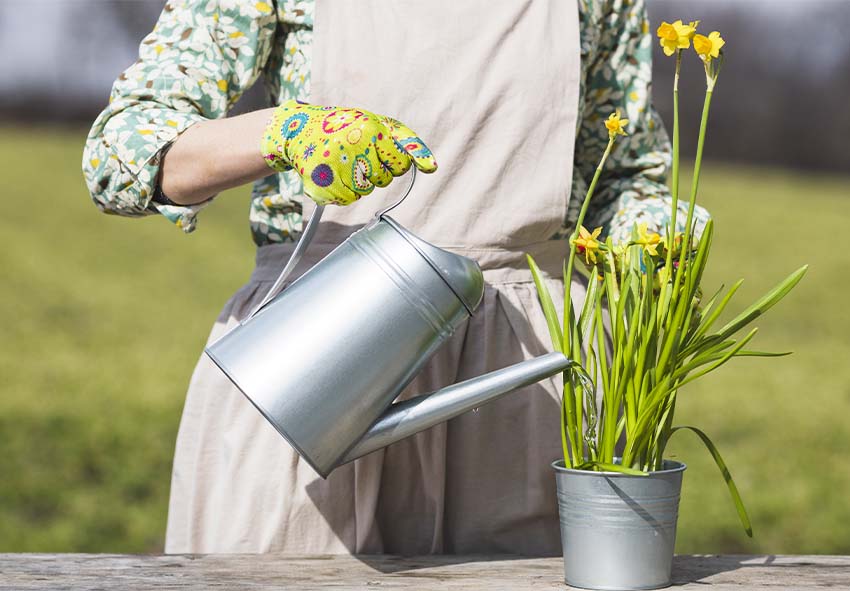
Caring for daffodils is essential to ensure these vibrant flowers return year after year with robust blooms. Proper maintenance involves understanding their watering, light, and fertilization needs throughout their growth stages. Additionally, knowing how to prune and manage their dormancy period will keep your daffodils healthy and flourishing. This section will guide you through the best practices for nurturing your daffodils to achieve a beautiful and long-lasting display.
Watering Needs
Proper watering is crucial for daffodil health. During the growing season, keep the soil consistently moist but not waterlogged. Water the plants thoroughly when the top inch of soil feels dry. After blooming, continue to water until the foliage starts to yellow. Once the leaves have died back, reduce watering as the bulbs enter dormancy.
Light and Temperature Requirements
Daffodils thrive in full sun to partial shade. They require at least 6 hours of sunlight daily for optimal growth and blooming. Daffodils are hardy plants that can tolerate a range of temperatures. They grow best in regions with cool winters and moderate springs. In hotter climates, provide some afternoon shade to protect them from extreme heat.
Fertilizing Daffodils
To ensure healthy growth and vibrant blooms, fertilize daffodils with a balanced fertilizer. Apply a slow-release bulb fertilizer or a general-purpose fertilizer with equal parts nitrogen, phosphorus, and potassium. Fertilize once in early spring when shoots emerge and again after flowering to help the bulbs store energy for the next season. Avoid high-nitrogen fertilizers, as they can promote excessive foliage growth at the expense of blooms.
Pruning and Deadheading
Pruning and deadheading are essential for maintaining the health and appearance of your daffodils. This tips enables the bulbs to store energy for the next growing season:
- Remove Spent Flowers: Deadheading, or removing spent flowers, is crucial to redirect the plant’s energy from seed production back into bulb development. Snip off the faded blooms just below the base using clean garden shears.
- Leave Foliage Intact: Allow the foliage to remain after flowering. The leaves continue photosynthesis, providing energy for the bulb to store nutrients for the next growing season. Cut back the foliage only after it turns yellow and begins to wither naturally.
- Avoid Braiding or Tying: Unlike tulips, daffodil leaves should not be braided or tied. This practice can restrict the leaves’ ability to gather sunlight and produce nutrients, potentially weakening the bulb over time.
- Dispose of Debris: Clean up any dead leaves or debris around the daffodil plants to prevent the spread of diseases and pests. Proper sanitation helps maintain a healthy environment for the bulbs and promotes longevity in the garden.
- Inspect for Pests and Diseases: Regularly inspect daffodil plants for signs of pests like aphids or diseases such as narcissus bulb fly. Early detection allows for prompt treatment, preserving the health of the bulbs and ensuring robust blooms in the following seasons.
Encouraging Blooming
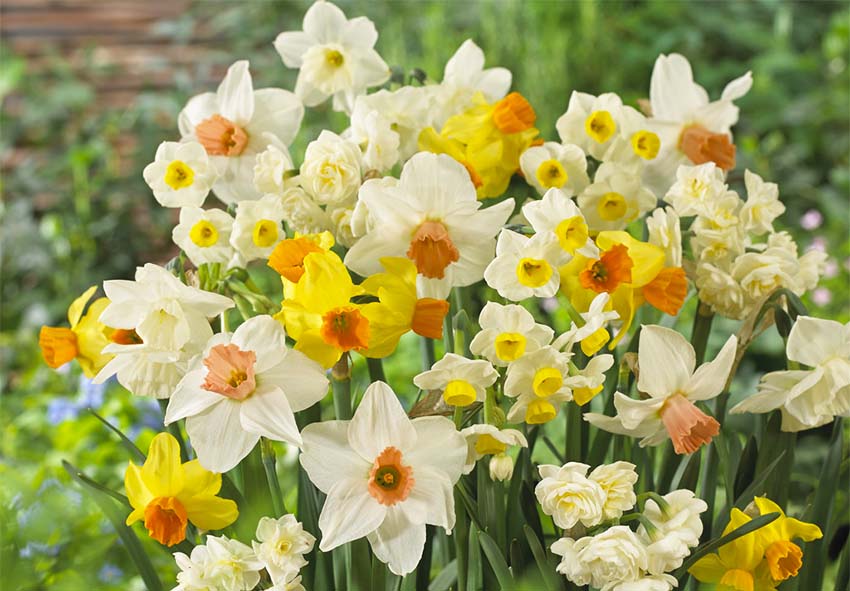
Ensuring your daffodils bloom beautifully each year requires more than just basic care. Understanding and managing their dormancy period is crucial for robust flowering. This section will provide insights into how to encourage blooming by mimicking natural conditions and addressing common blooming challenges.
Dormancy Period
Daffodils require a dormancy period to rejuvenate and prepare for the next blooming cycle. After the foliage dies back, the bulbs enter a rest phase. During dormancy, refrain from watering and allow the soil to dry out. If you live in a region with mild winters, consider digging up the bulbs and storing them in a cool, dark place for a few months to simulate winter conditions. This practice helps ensure strong, vigorous blooms in the following spring.
By following these care tips, you can enjoy a stunning display of daffodils year after year. Proper watering, fertilizing, and pruning will keep your plants healthy and vibrant, while understanding the dormancy period will help you manage their blooming cycle effectively.
Daffodil Aftercare
Proper aftercare is essential to ensure that your daffodils remain healthy and continue to produce vibrant blooms year after year. After daffodils finished flowering, specific steps must be taken to care for the bulbs and prepare them for the next growing season.
Post-Bloom Care
After the daffodils have finished blooming, it’s essential to continue caring for them to ensure they store enough energy for the next growing season. Allow the foliage to remain on the plants until it turns yellow and dies back naturally. This process helps the bulbs photosynthesize and store nutrients. During this time, you can remove the spent flower heads to prevent seed formation, which diverts energy from the bulbs.
Storing Bulbs for Next Season
Proper storage of daffodil bulbs is crucial for successful replanting. Once the foliage has completely died back, carefully dig up the bulbs. Clean off any soil and allow them to dry in a cool, airy place for a few days. Store the bulbs in a paper bag or mesh sack in a dry, dark location with good air circulation. Avoid plastic bags, as they can trap moisture and cause rot. The ideal storage temperature is between 50-60°F (10-15°C).
Repotting Daffodils
Repotting daffodils can rejuvenate the plants and improve blooming. It is best to repot them every 3-4 years. To repot, carefully dig up the bulbs after the foliage has died back. Separate any offsets from the parent bulbs and discard any that are damaged or diseased. Replant the bulbs in fresh, well-draining soil, ensuring they are planted at the appropriate depth (about 6-8 inches). Water them thoroughly to help them settle into their new environment.
Common Pests and Diseases
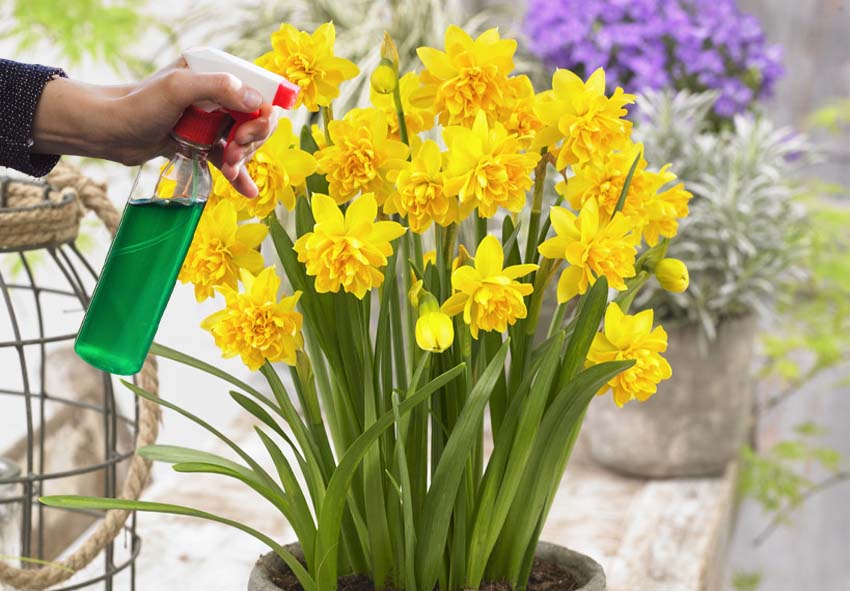
Daffodils are relatively resistant to pests, but they can still be affected by certain insects. Common pests include:
- Narcissus Bulb Fly: Large flies that lay eggs on the bulbs, leading to maggots feeding on them.
- Aphids: Small, sap-sucking insects that can weaken the plants and transmit viruses.
- Slugs and Snails: Mollusks that chew on the leaves and flowers, causing significant damage.
To identify these pests, look for signs such as holes in leaves, distorted growth, and sticky residue on the plants.
Preventing and Treating Diseases
Daffodils can be susceptible to various diseases, often caused by fungi or bacteria. Common diseases include basal rot, narcissus smolder and viruses. To prevent and treat these diseases:
- Maintain Good Hygiene: Clean tools and remove any diseased plant material promptly.
- Ensure Proper Drainage: Plant daffodils in well-draining soil to prevent waterlogging, which can lead to fungal infections.
- Use Fungicides: Apply appropriate fungicides if you notice signs of fungal diseases.
- Practice Crop Rotation: Avoid planting daffodils in the same spot every year to reduce the risk of soil-borne diseases.
By following these aftercare and pest management tips, you can keep your daffodils healthy and ensure they continue to brighten your garden with their beautiful blooms year after year.
Creative Uses for Daffodils
Daffodils are not just a garden delight; they offer endless creative possibilities beyond their traditional role in landscapes. Whether adorning floral arrangements, serving as thoughtful gifts, or inspiring decorative potting ideas, daffodils bring a burst of color and cheerfulness to any setting. This section explores innovative ways to showcase daffodils, making them a versatile and vibrant addition to both indoor and outdoor spaces.
Daffodils in Floral Arrangements
Daffodils add a cheerful touch to floral arrangements with their bright colors and distinctive trumpet-shaped blooms. Combine them with other spring flowers like tulips and hyacinths for a vibrant bouquet. Their sturdy stems make them ideal for tall centerpieces or simple, elegant vase displays.
Daffodils as Gift Plants
Giving daffodils as gifts is a thoughtful gesture, especially during the spring season or for special occasions like birthdays or Mother’s Day. Choose potted daffodil plants that are already in bloom or gift bulbs in decorative containers. Include care instructions to ensure the recipient can enjoy the blooms indoors or plant them in their garden for future seasons of beauty.
Decorative Potting Ideas
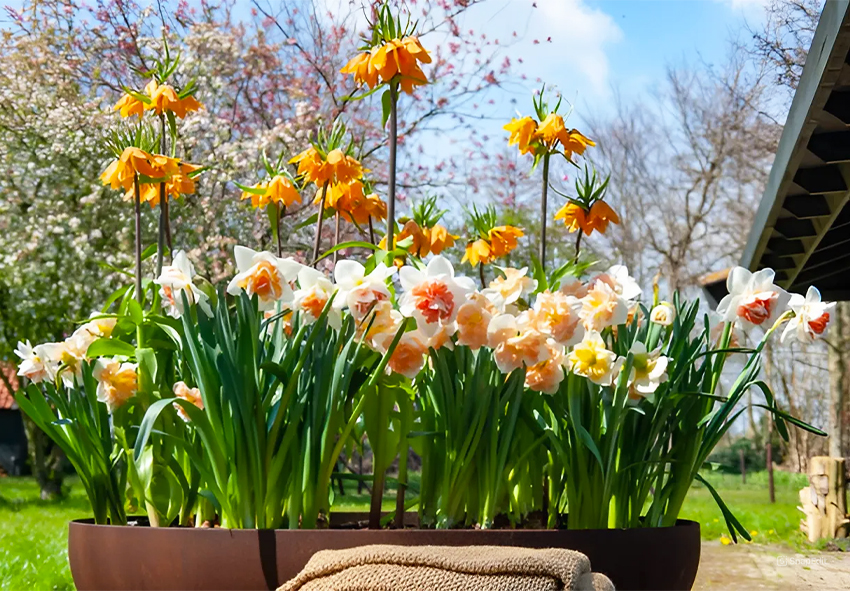
Enhance the display of daffodil plants with creative potting ideas. Experiment with layers of bulbs for a continuous bloom throughout the season. Here are some ideas:
- Vintage Containers
Repurpose old tin cans, antique teapots, or weathered wooden crates to create a nostalgic charm in your garden or home. Vintage containers add character and history to your daffodil displays, enhancing their overall appeal.
- Colorful Ceramic Pots
Choose vibrant glazed ceramic pots in hues like cobalt blue, sunny yellow, or emerald green to showcase the vivid colors of daffodil blooms. These pots not only provide a pop of color but also complement the cheerful nature of daffodils.
- Rustic Wooden Crates
Opt for sturdy wooden crates with a weathered finish to create a rustic and natural backdrop for your daffodils. Arrange different varieties of daffodils in these crates for a charming country-style display that highlights their beauty in an organic setting.
Conclusion
In this comprehensive guide, we’ve explored everything you need to know about planting, caring for, and creatively using daffodils to enhance your garden and living spaces. Whether you’re incorporating them into floral arrangements, gifting them for special occasions, or exploring decorative potting ideas, daffodils bring joy and beauty wherever they grow.
Remember, with proper care and attention, daffodils will reward you with their cheerful blooms season after season. Embrace their versatility and let these lovely flowers brighten your garden and inspire your creativity.
Frequently Asked Questions (FAQs) about Daffodils
1. When is the best time to plant daffodil bulbs?
Daffodil bulbs are best planted in the fall, ideally from September to November, before the ground freezes. This timing allows the bulbs to establish roots before winter and bloom beautifully in spring.
2. How often should I water daffodils?
Daffodils prefer well-drained soil and typically do not need much watering once established. During their active growth phase in spring, water them regularly if there is no rainfall. After flowering, gradually reduce watering as they enter dormancy.
3. Do daffodils need to be fertilized?
Yes, daffodils benefit from fertilization to support healthy growth and flowering. Apply a balanced fertilizer, such as a 10-10-10 formula, in early spring as the foliage emerges. Avoid excessive nitrogen, which can lead to lush foliage but fewer blooms.
4. How do I prevent pests and diseases in daffodils?
To prevent pests like aphids and diseases such as narcissus bulb fly, practice good garden hygiene by removing debris and dead foliage around daffodil plants. Avoid overcrowding and ensure proper soil drainage to reduce the risk of bulb rot.
5. Can I order Dutch daffodil bulbs from your online store?
Yes! Check our store Dutch-bulbs.com for availability and enjoy the convenience of having top-quality daffodil bulbs delivered to your doorstep, ready for planting in the fall. Ordering from us ensures you receive high-quality bulbs that have been stored and handled with care.
Published: 14.06.2024
